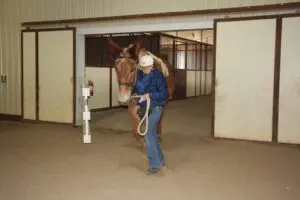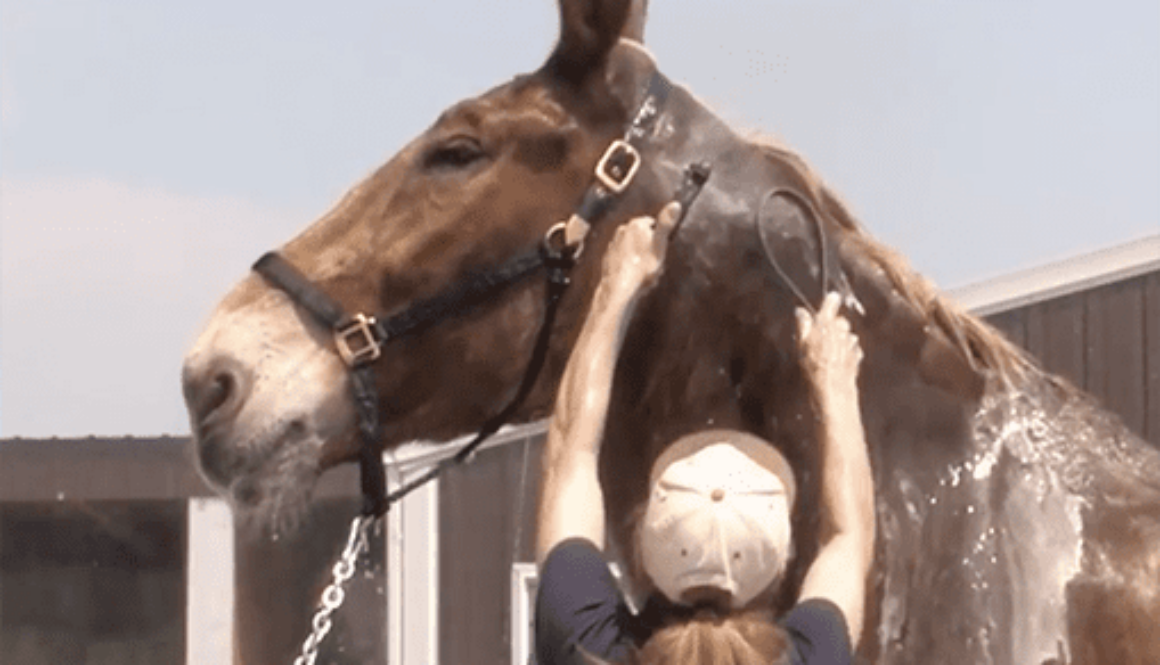
Roll



MULE CROSSING: Looking Objectively at Your Equine
By Meredith Hodges
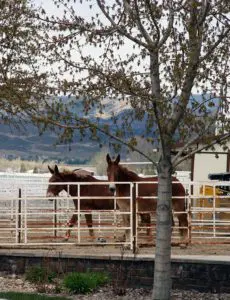 Before most of us learn anything about horses, mules and donkeys, we tend to initially perceive them as large, strong and durable animals that can safely carry us anywhere we want to go and can participate in any number of equine events. This is essentially true. However, there can be a number of pitfalls along the way if you do not educate yourself and practice good maintenance, feeding and training practices.
Before most of us learn anything about horses, mules and donkeys, we tend to initially perceive them as large, strong and durable animals that can safely carry us anywhere we want to go and can participate in any number of equine events. This is essentially true. However, there can be a number of pitfalls along the way if you do not educate yourself and practice good maintenance, feeding and training practices.
Equines, like people, are comprised of living tissue, bones, muscles and tendons that can often experience improper growth and development, which can compromise their performance. This is why it is important to feed your equine’s living tissue, bones, muscles and tendons a healthy diet and exercise him in a way that builds these elements using natural and non-stressful techniques that will help your equine to strengthen properly in the right frame, or posture.
It is also important to make sure the tack you use fits well and is adjusted properly. An equine that is experiencing soreness from ill-fitting tack will be distracted from his best performance. Improve your own skills by taking care of your own body as you observe and condition your equine. The person who eats healthy food, exercises in good posture and improves his or her own general conditioning, coordination and Horsemanship skills will not be out of balance and will not compromise the equine’s ability to perform.
 Let’s take this one step at a time. First, make sure that your equine is stabled in a place where he has adequate shelter from the elements, plenty of room to exercise himself when you are not there, clean water and a good feeding schedule. When an equine is nervous or high strung, it can usually be attributed to this very elemental beginning. Many show horses are kept in 12-foot by 12-foot stalls with limited turnout during the day, usually only an hour or two. Think about this for a minute. The equine is a grazing animal and his natural health is enhanced by what he eats and the fact that he is moving with his head down most of every day of his life. The only time his head is truly raised is when he is on alert.
Let’s take this one step at a time. First, make sure that your equine is stabled in a place where he has adequate shelter from the elements, plenty of room to exercise himself when you are not there, clean water and a good feeding schedule. When an equine is nervous or high strung, it can usually be attributed to this very elemental beginning. Many show horses are kept in 12-foot by 12-foot stalls with limited turnout during the day, usually only an hour or two. Think about this for a minute. The equine is a grazing animal and his natural health is enhanced by what he eats and the fact that he is moving with his head down most of every day of his life. The only time his head is truly raised is when he is on alert.
The equine that is stabled in a stall isn’t urged to have his head down for any more time than it takes to eat up the loose hay after his feedings. His body is forced to remain in a very small range of movement and he can become stiff and sore when asked to do things that require more flexibility in his work. When fed high protein feeds in this situation, he is not able to expend the energy to burn this feed, and it can manifest itself in nervous and anxious behavior. Therefore, it is critical to your equine’s health that he is not only fed the right kinds of feeds and supplements, but that he is able to expend this energy in a healthy way for his body to grow and develop properly.
 Muscles in the equine’s body, like our own, are structured in distinctive layers and are supported by ligaments and tendons. These muscles need to be strengthened in a specific order for optimum performance. Whether he is a foal or an older animal, his athletic conditioning needs this taken into consideration. The first exercises should be passive and easy to facilitate the strengthening of the core muscles closest to the bone. This is done with exercises on the lead line. It is not as important that he learns to negotiate obstacles on the lead line as it is how he negotiates the obstacles on the lead line.
Muscles in the equine’s body, like our own, are structured in distinctive layers and are supported by ligaments and tendons. These muscles need to be strengthened in a specific order for optimum performance. Whether he is a foal or an older animal, his athletic conditioning needs this taken into consideration. The first exercises should be passive and easy to facilitate the strengthening of the core muscles closest to the bone. This is done with exercises on the lead line. It is not as important that he learns to negotiate obstacles on the lead line as it is how he negotiates the obstacles on the lead line.
On the approach to an obstacle, your equine needs to be relaxed and comfortable. It is your job as his trainer to show him how to do this. When you lead in good posture, walk straight lines and make smooth, gradual arcs and turns, you will encourage your equine to do the same. Using short pauses between changes of pace or direction will help your equine to stay calm and receptive to training.
 For instance, when approaching a bridge, walk with your equine’s head at your shoulder as if you were in a showmanship class. Stop at the foot of the bridge and encourage your equine to stretch his nose down and investigate the bridge in order to allay any fears he might have. When your animal has indicated he is not afraid by once again raising his head level with his withers, you can proceed. Face the bridge straight on, looking straight ahead and, while keeping his head at your shoulder, take the first step straight forward and onto the bridge, making sure he follows and places one front foot on the bridge itself. Next, ask him to place the other front foot onto the bridge, stop, square up his four feet (as in Showmanship) and reward. Continue forward in a straight line. Once all four of his feet are on the bridge, stop, square up and give him a reward. Then continue across the bridge maintaining your own good posture, hesitate at the last step, and then step off carefully, in good balance and with a coordinated effort. Ask him to place his two front feet on the ground while leaving the back feet on the bridge, stop, square up and reward. Your equine will learn to follow your lead and execute the task in the same balanced and coordinated manner and will be able to halt on command at any location.
For instance, when approaching a bridge, walk with your equine’s head at your shoulder as if you were in a showmanship class. Stop at the foot of the bridge and encourage your equine to stretch his nose down and investigate the bridge in order to allay any fears he might have. When your animal has indicated he is not afraid by once again raising his head level with his withers, you can proceed. Face the bridge straight on, looking straight ahead and, while keeping his head at your shoulder, take the first step straight forward and onto the bridge, making sure he follows and places one front foot on the bridge itself. Next, ask him to place the other front foot onto the bridge, stop, square up his four feet (as in Showmanship) and reward. Continue forward in a straight line. Once all four of his feet are on the bridge, stop, square up and give him a reward. Then continue across the bridge maintaining your own good posture, hesitate at the last step, and then step off carefully, in good balance and with a coordinated effort. Ask him to place his two front feet on the ground while leaving the back feet on the bridge, stop, square up and reward. Your equine will learn to follow your lead and execute the task in the same balanced and coordinated manner and will be able to halt on command at any location.
In the beginning, your equine may be fearful and nervous about going over the bridge or any other obstacle. It is enough at this time that he gets over his fear and just crosses it, whether it is done with finesse or not. Once he is over the fear of crossing the obstacle, you can begin working on his ability to cross with finesse, balance and coordination. The longer you work on perfecting the negotiation of an obstacle in a balanced and coordinated way, the stronger the participating muscle groups will become and the more comfortable and automatic the movement will become until it develops into a habit.
The part you play in all of this is very important. You will discover that if you are not in balance and coordinated in the way you move with your equine, the less balanced and coordinated he will be. If you don’t walk straight, then neither will he. If you are not confident in your approach, then he won’t be either. Even something as simple as the tack you use will play a big part in your equine’s performance. If the halter is too small or too large, it can cause irregular pressure on your animal, preventing him from complying with your wishes. How you move your equine’s head with the halter and lead line can affect his performance. Pay attention to how hard you need to pull to get even the smallest response and be ready to release pressure immediately upon compliance. But again, when releasing pressure, just give him enough slack to release the pressure and not so much that you have a lot to take back later. This will help him keep his attention on you and the task at hand. Keep this minimal degree of pressure-and-release throughout his work. Even if he backs away from an obstacle, just give little tugs followed by a release to allow him to back and then encourage him to re-approach the obstacle by coming from another angle or by coaxing him with the promise of a reward upon his attempt. Another approach is to go to the end of the lead rope, keep the rope taut and invite him to come forward by revealing the oats reward he will get when he complies. Take up the slack as he approaches. Avoid resistance at all costs!
 Halters that are too loose allow too much lag time between the time you ask by giving a tug and the time the equine receives the message. This usually results in an over-reaction from your equine and then an over-reaction from you as you try to correct the mistake. A halter that is too tight can be a distraction because it can create sore spots—the equivalent to a headache and no one likes to perform with a headache! The lead line typically should be a length that you can easily handle and that will give your equine some room to move away, but that can be reorganized easily, usually about six to eight feet long.
Halters that are too loose allow too much lag time between the time you ask by giving a tug and the time the equine receives the message. This usually results in an over-reaction from your equine and then an over-reaction from you as you try to correct the mistake. A halter that is too tight can be a distraction because it can create sore spots—the equivalent to a headache and no one likes to perform with a headache! The lead line typically should be a length that you can easily handle and that will give your equine some room to move away, but that can be reorganized easily, usually about six to eight feet long.
No matter how careful you may be, there will always be times when your equine will experience some kind of soreness from playing too hard in the pasture or from kicking in a stall, to any number of daily hazards. How he is negotiating his obstacles and how he performs certain movements will give you clues to how he is feeling. Learn to watch every step your animal takes, how his feet are placed, how his body is moving and the look on his face as he performs a given task.
 This is when it can be beneficial to know the basics of equine massage therapy. There is a lot that you, as your equine’s trainer, can do without a professional equine masseuse, but you should always consult with a professional for lessons on how you can do your part. Make sure that the equine masseuse you decide to use is a person who knows equines and has at least 500 hours experience with equine massage therapy. Once you learn some massage techniques, you can often alleviate minor soreness exhibited by your equine. When your equine senses that your goal is to make him comfortable as well as successful in his work, he will be much more willing and able to comply.
This is when it can be beneficial to know the basics of equine massage therapy. There is a lot that you, as your equine’s trainer, can do without a professional equine masseuse, but you should always consult with a professional for lessons on how you can do your part. Make sure that the equine masseuse you decide to use is a person who knows equines and has at least 500 hours experience with equine massage therapy. Once you learn some massage techniques, you can often alleviate minor soreness exhibited by your equine. When your equine senses that your goal is to make him comfortable as well as successful in his work, he will be much more willing and able to comply.
The specifics of training techniques covered in this article can be found in the Equus Revisited manual and DVD.
To learn more about Meredith Hodges and her comprehensive all-breed equine training program, visit LuckyThreeRanch.com, MEREDITH HODGES PUBLIC FIGURE Facebook page, or call 1-800-816-7566. Check out her children’s website at JasperTheMule.com. Also, find Meredith on Pinterest, Instagram, MeWe, YouTube and Twitter.
Covered in TRAINING MULES & DONKEY: A LOGICAL APPROACH TO TRAINING, TRAINING WITHOUT RESISTANCE and EQUUS REVISITED at www.luckythreeranchstore.com.
© 2004, 2011, 2016, 2017, 2024 Lucky Three Ranch, Inc. All Rights Reserved.


What’s New with Roll? Goodbye Roll
February 11, 2019
Unfortunately, after eight years together, Roll passed quietly from a mild colic and weakness in his hind quarters on February 11, 2019 at the age of 27 years. I rescued Rock and Roll from slaughter in December of 2010. We lost Rock in December of 2011 with a completely shattered hip joint after being rendered sound at the walk with no medications for a whole year. With ring bone and side bones in three hooves, I continued working with Roll and we met our goal of being sound enough to ride around the hay field for several years.
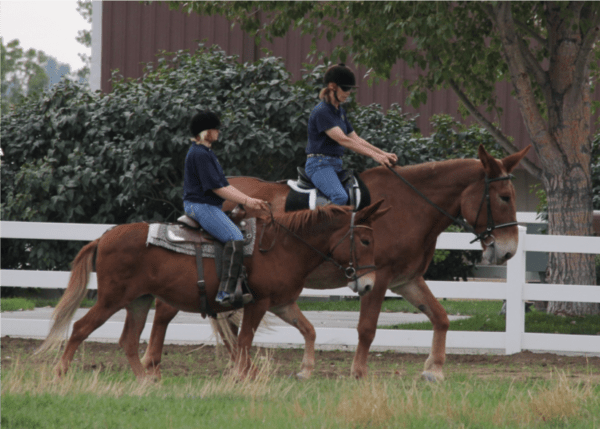
Roll survived a severe bout with White Line Disease in 2016. We had to resect 2/3 of his hoof wall and it only because of his good posture and core strength that he was able to “balance” his way through his treatments which changed weekly. It took eight months, but his left hind foot finally grew back completely (see 2016 posts).







…and afterwards, he was able to be ridden once again.

Roll began his time with me as a suspicious and spooky guy, but he studied his manners, his training lessons and we became the very best of friends. Since most drafts don’t live past 20, I feel blessed to have had him for as long as I did! Just before he died on February 11, 2019 (his hind legs were finally too weak for him to get up after his morning nap), he reached his nose from the ground to my cheek and gave me one of his soulful nuzzle kisses…a sincere thank you for a life well lived! He has crossed the Rainbow Bridge and joined his mate, Rock, that we both loved and missed so much! In my heart, I know we will eventually be together again.





What’s New with Roll? A Great Massage and a New Friend!
10-25-18
Roll had a good massage today! He seems to really enjoy the new Equisport massager. You can always tell when your equine enjoys his massage because he will “talk” to you along the way. Notice how Roll is pushing his hip into the massager in the first photo? That means, “Feels so good… go deeper!”

His left hind is often a bit sore from his twisting in the right hind, so he isn’t too sure about it at first, but the right hip is a different story and he relaxes. He even slid his hind leg slightly forward to allow Joanne to massage deeper.

It seemed that the left shoulder is a bit sore and he gives her a stern look of “Be careful now.”

Joanne spoke back to Roll with “I hear you! So we’ll go to the other side and move on to something else.” Roll responded with, “Oh, yes, this is a better spot!” as he relaxed his hind foot and leaned into the massager again.

Roll rounded his neck to look back to her and said, “Are you wearing a fanny pack full of oats today?”

Joanne responded with, “Nope, sorry! How about an eyeball massage?”

Roll leaned into the massager and went to town pushing his eye into the massager while Joanne just held it steady. He was in seventh heaven!


When it came to his ears, Roll went into a trance and enjoyed every minute of his full face massage!


Then she went across his back and over his rear end to finish. Roll looked at her as if to say, “Thanks for a GREAT massage…feels soooo good!”

After Rock’s death in 2011, Roll spent the last 7 years in turnout alone with only his two mini donkey friends, Spuds and Augie, across the fence from him.

The best part of the weekend following his massage was that 26-year-old Roll finally got a friend in turnout! Billy Bad Ass (age 25) came to us a month ago. We thought the two gelding boys would enjoy each other as they are pretty close in age and it proved to be true!
Roll was truly happy to have a brand new buddy!

three

What’s New with Roll? Ground Driving the Pasture
8-31-18
Roll needed another core tune-up today, but every time we take him out, we need to document everything in photos and video. Normally we would work in the hourglass pattern, but we wanted better pictures than just the arena sand and fences so we decided to do some ground driving today in the 5-acre pasture instead.

I had to tighten the reins that were tied up to the surcingle because he thought it might be nice to just lower his head and graze…that was not in the program!

He was light in the bridle and easily maneuverable. I was glad to be able to walk behind and see how his rear end was moving. It was VERY wobbly from both hips and could not walk a straight line.

He will most definitely need more chiropractic work and massage going forward. I think regular core exercises are in order, once a week in order to build up his rear end bulk muscle again. We did a serpentine through the trees …

… and then left the field along the fence line to help him to stay straight. That should help to stabilize the rear, but he IS a 26 year-old with a very bad start to his life for the first 18 years, so I need to keep expectations realistic.

He lacked impulsion for the first part of the ground driving, but was beginning to engage the hind quarters a bit more and that added enough impulsion for him to go forward in a straighter line than he did at first as he traveled along the fence line.

Although I had tightened the reins coming from the bridle, Roll still managed to lower his head sideways and grab a few blades of the taller grass on the way out!!! He cracks me up!

He did remarkably better on the gravel road back to the Tack Barn. I did have to keep reminding him to keep his body straight, which he did very easily.

When we got back to the Tack Barn he drove right in and parked himself, squaring up upon my request through the lines. What a good boy!!!


What’s New with Roll? Hourglass Pattern, Stretching & Backing
7-12-18
Roll had his summer bath yesterday and it was a great day for it! It was 100 degrees!
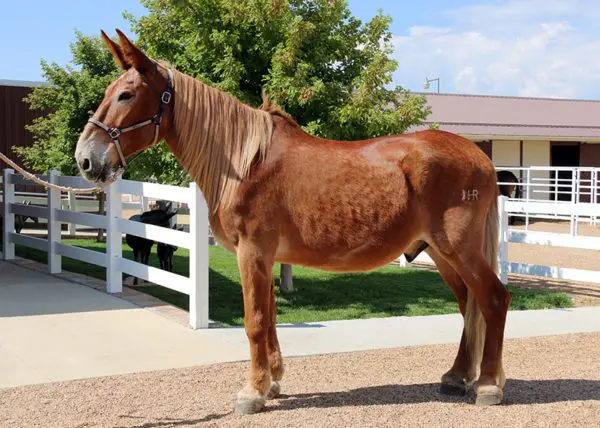
Today it was a little cooler, so we opted to go to the dressage arena and work in the hourglass pattern on the lead rope in his “Elbow Pull” and surcingle.

The twisting in his right hind foot was markedly better today after last week’s workout. I am glad I made the call to go back to the leading exercises after his riding experience on May 6. He felt sluggish and the right hind foot was not adequately supported and was twisting quite a bit.

Going back to his core leading exercises for the past few weeks has greatly improved the musculature and corresponding soft tissues, ligaments and tendon that support the pastern and fetlock and the twisting has substantially subsided. He now has a much more upward balance!

I find it amusing that these animals really DO mirror what we do, so it is best to pay attention to what YOU are doing as well as what your mule is doing!




Because you can’t necessarily SEE core muscle development, it is hard to tell how much it can help the equine with his overall posture, balance and performance. Once you have engaged in the exercises, you can begin to identify these very subtle nuances in the equine’s way of moving.

We often talk about “head sets” in the equine world and want our equines to be soft and supple in their poll, but what of the rest of the body? When the body is truly in good postural balance, it is easy for the equine’s WHOLE BODY to perform as it was intended.

The animal is soft and pliable throughout his body and you will begin to notice when they are using their whole body and when there are compromised segments. The easiest thing to see is how an animal with adequate core strength will use ALL his muscles such that you can actually see the muscles rippling in motion over the ribs.

The animal without core strength will be stiff and immobile over the ribs and the legs will move underneath the body, but neither adds support nor fluidity to his movement. ROLL is living proof of this drastic difference in conditioning.

We finished Roll’s lesson with some simple stretching exercises…



…then walked to the gate with the lead slung over his neck…

…and then backed a few steps, all evidence of his own good postural body carriage. I am so pleased that Roll is doing so well at 26 years old!


What’s New with Roll? Roll’s Insights into Massage Therapy
5-17-18
Massage for equinesis now used more often as an alternative or complementary healing process toward health and fitness.
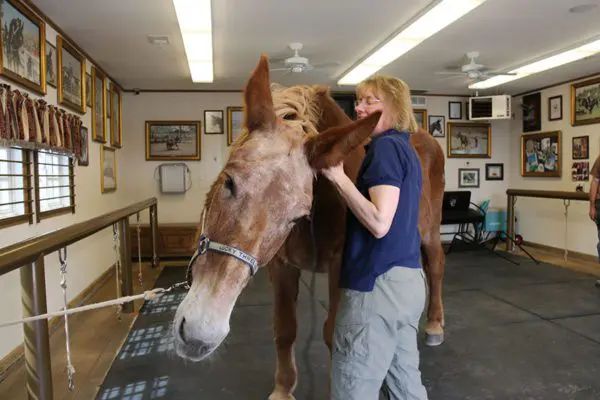
Simple massage can prevent various injuries throughout your animal’s lifetime. Don’t wait for obvious injury to occur—preventive massage increases the length of the muscle fibers, taking pressure off the joints.
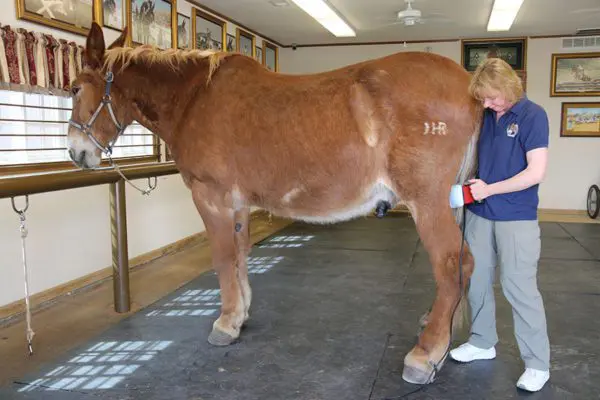
When the muscles are allowed to contract and expand to their full length, they are able to absorb important nutrients that reduce fatigue. Massage also increases blood flow, which helps the body flush harmful toxins, such as lactic acid, that build up from normal use.
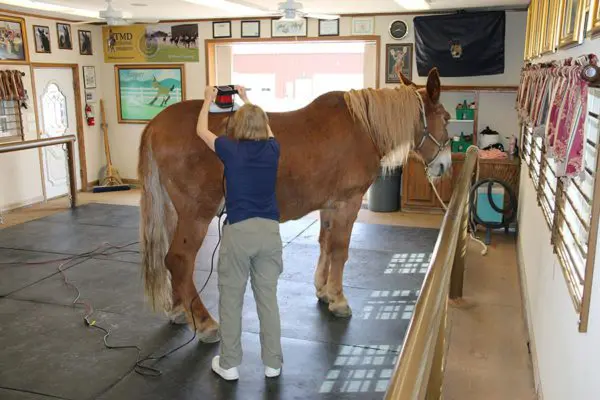
Massage aids in reprogramming the nervous system to break patterns that can cause atrophy or knotted tissue. If you are unsure as to the severity of an injury, consult your vet!
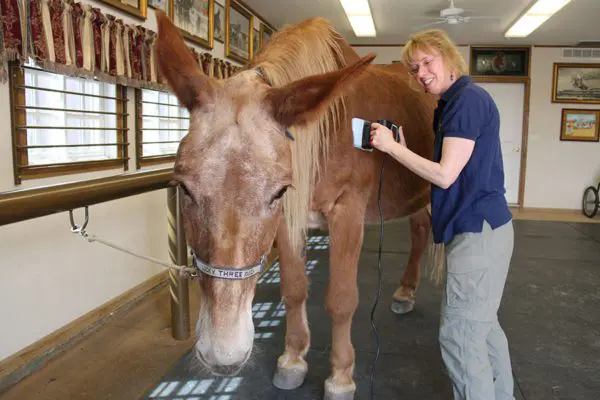
At Lucky Three Ranch, I have found that therapeutic equine massage promotes relaxation and reduces stress. It also stimulates healing after an injury and provides significant relief from pain as it did when Roll had White Line Disease in 2016-17.
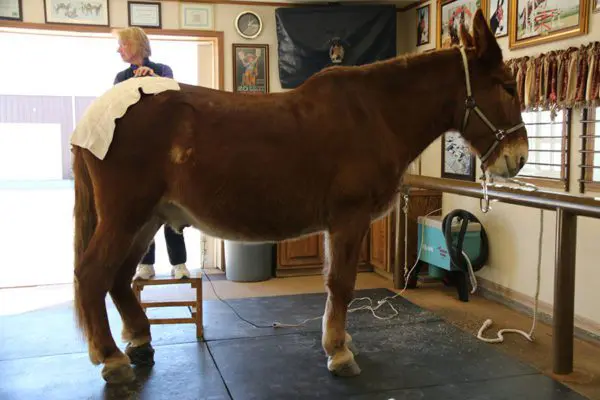
Massage can reduce muscle spasms, and greater joint flexibility and range of motion can be achieved through massage and stretching—resulting in increased ease and efficiency of movement.
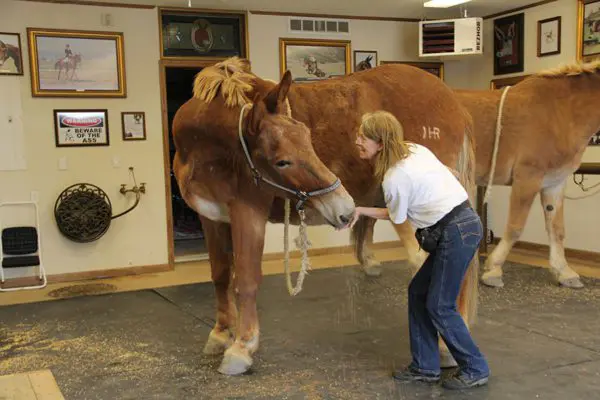
Always be aware of your animal’s reaction to pressure and respond accordingly. Watch his eyes and ears. As you work look for signs of sensitivity toward the affected area such as biting, raising and lowering the head, moving into or away from pressure, contraction of muscles from your pressure, tossing his head, swishing his tail, picking up his feet, changes in his breathing or wrinkles around his mouth.
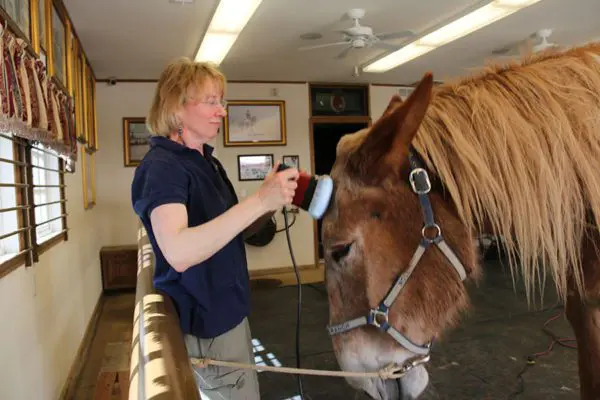
If your animal is heavy in the bridle, if he tips his head to one side, or if he has difficulty bending through the neck, he is exhibiting stiffness in this area.
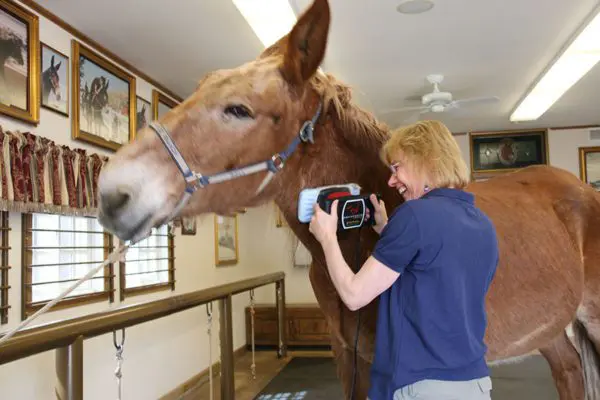
If he moves away, he is telling you that you are exerting more pressure than he can comfortably endure, and you should go back to using your fingertips.
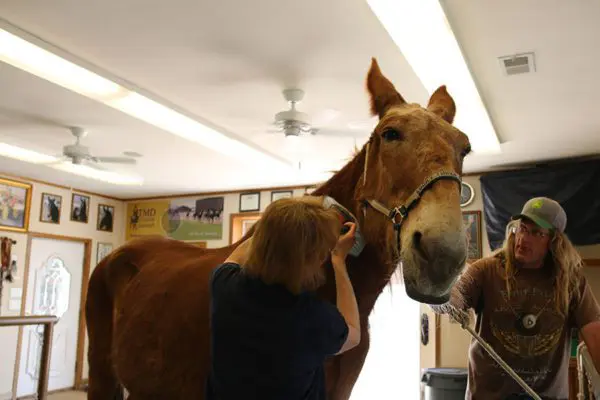
A raised head and perked ears may indicate sensitivity. He is asking for lighter pressure, so learn to pay attention to the things your animal tells you about his body.
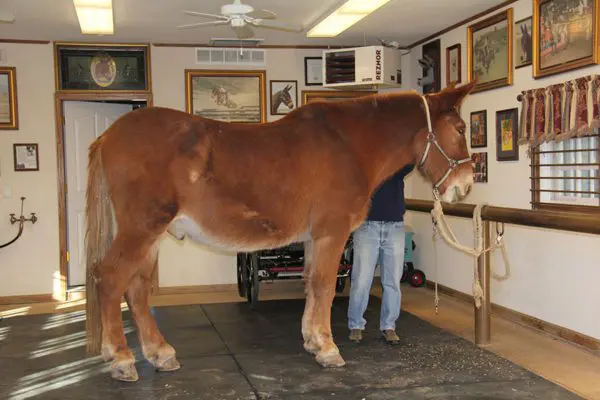
Massage therapy should never be harmful. For the sake of safety and comfort, do not attempt massage therapy for rashes, boils, open wounds, severe pain, high fevers, cancers, blood clots, severe rheumatoid arthritis, swollen glands, broken bones, direct trauma or if there is any chance of spreading a lymph or circulatory disease, such as blood poisoning. Avoid direct pressure on the trachea.
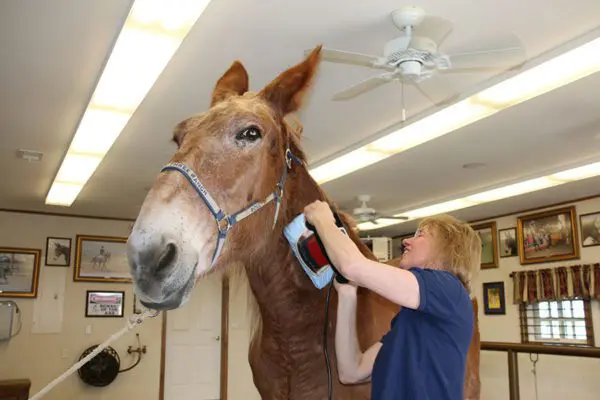
It is easiest to find sore spots and muscles when your animal is warmed up, so after a ride is a good time to do massage therapy and passive range-of-motion exercises.
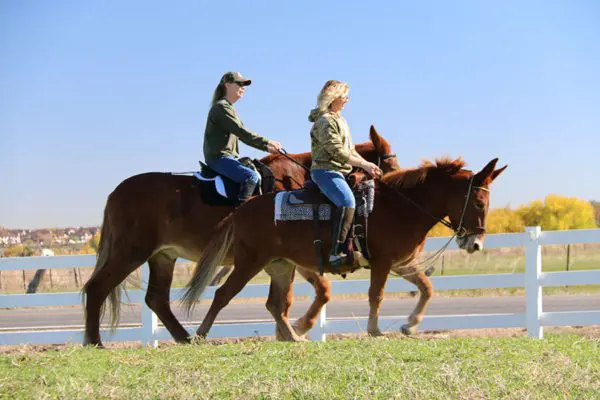
Each time you ride, take the time to quickly go over your animal and assess his sensitive areas: check his range of motion to detect stiffness in the joints. Paying this kind of attention to his body will enhance his athletic performance and provide him with a wonderfully relaxing reward. Give your equine the preventive care that he deserves to make your way to a mutually satisfying relationship.
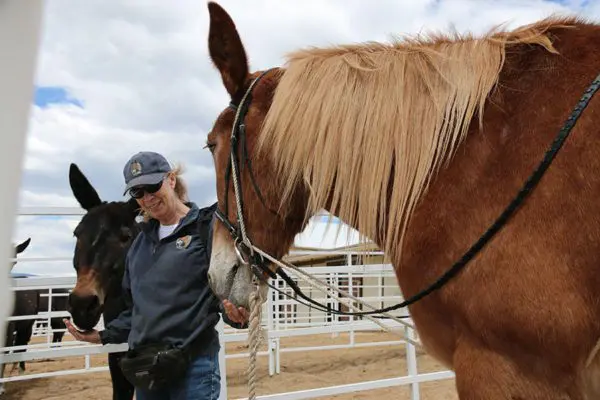

What’s New with Roll? A Walk in the Jump Course
5-8-18
After about an hour of shedding grooming with the hairbrush, shedding blade and then the vacuum, Roll and I headed out for a walk around the jump course. We started at the Tack Barn and walked through the alleyway between the buildings.
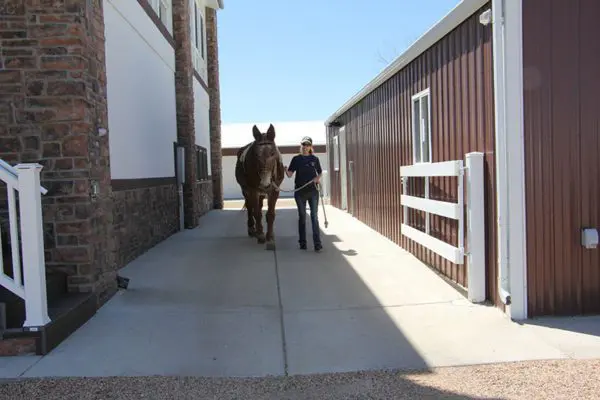
We stopped occasionally along the driveway to square up and he seemed to be reluctant to weight the right hind again, but after a few times, he did better. We stopped at the MULE CROSSING sign for a photo-op.

Then we went down the beautiful tree-lined driveway on our way past the mules in the dirt pen having lunch, and past Jasper Bunkhouse, to the jump course area.

We stopped again at the statue of Lucky Three Eclipse, my hunter champion, situated behind our equipment barn where all the hay equipment is stored. Roll was more interested in the “Ely” statue than he was with the photo-op!

The grass was pretty tall and made for difficulty walking through it, but Roll was willing and did not dive for the grass, but obediently kept his head up, moving freely forward.

As long as he was walking, he was obedient. Then when I stopped him and asked him to square up, he became more interested in the grass and was not that willing to stand still for very long each time he stopped.

I guess the temptation was just too much for him, so I let him have a nibble! The reins tied up to the surcingle only allowed him to crop the ends off the tall grass.

We then walked on a little farther, enjoying the sunshine, the beautiful Rocky Mountains in the background, and the warm weather.

We stopped for another photo-op in the grass, but he did not stay squared up for the picture. He was still slightly distracted by the grass and apparently moved, but at least he wasn’t being pushy about it and smiled for the camera!

He really didn’t want to leave the grass, but he followed me nevertheless and squared up again on the road. At 18 hands, it’s a good thing he is as obedient as he is or he could have dragged me back into the grass!

We stopped again to see the Mae Bea C.T. statue. Roll had to reach out and take a good look at her pretty face!

He did pretty well overall. The walk was just enough to tune up his core. It’s hard to believe that he has now been with me for 8 years considering he was a rescue and supposedly a lost cause when I got him.

Roll is now 26 years old and I hope he still has many good years to come. It was a beautiful day and we both thoroughly enjoyed our walk together. Maybe next time, we’ll go for a ride!


What’s New with Roll? Winter Work in the Hourglass Pattern
Roll has been off for quite some time during this crazy winter weather that we have been having and due to the extra office work that I have taken on. Today we had an opportunity with warm temperatures, but avoided the mud from the snow by working indoors. First, I groomed Roll with a curry and then the vacuum cleaner. The vacuum cleaner is a great tool to promote circulation to the muscles over the body.

Johnson’s Baby Oil in the mane and tail help to protect the hair from the harsh winter weather, drying mud and prevents other equines from chewing on them.

Today we used my Kieffer dressage saddle that seems to fit most of my mules and Roll included with a girth extender. Then I put on the “Elbow Pull” and adjust it so that it helps him to keep his good posture throughout his lesson.

The “Elbow Pull” only prevents him from raising his head so high that he inverts his neck and hollows his back. Otherwise, it affords him full range of motion upward (to that point), downward to the ground and as far as he can stretch his head and neck to both sides.

We went to the indoor arena and he stood like a soldier while I closed the gate and prepped for our lesson in the hourglass pattern. It is extraordinary how core strength stays with these guys even when they are off work for long periods of time.

This is not true with bulk muscle or an animal that has not had the benefit of core strength postural development. The core strength that we develop in good posture is sustained by the equines themselves in their daily routines even when they do not receive forced exercise as long as they continue to move in good posture and rest four-square. Equines that rest with uneven foot placement, or cock a hind foot and drop a hip are not balanced in good posture with a strong core.

When saddling, we do it from the left side (near side) as done normally, but to keep things balanced, we unsaddle from the right side (off side) and pull the saddle back onto the rear end to loosen the crupper and make it easy to remove. When the equine is routinely handled like this, they learn to relax and stand quietly because they know what to expect.

It is amazing to see how much Roll’s attitude has changed in the eight years he has been with us. When he first arrived, he would snort at everything and hide behind Rock. He is now a happy, confident and affectionate 26 year old, 18 hand draft mule. He enjoys his lessons and never forgets a thing!

Trying new things is now done with much less effort and thus, much less drama! Yes, Roll is a bit obese with atrophied bulk muscle right now, but with routine lessons, he will be back to peak condition in no time. An equine that possesses a good foundation built with core strength in mind will be in a position to excel in all kinds of equine activities…because they are never over-whelmed.

What’s New with Roll? Cyst Removal
 12/22/17
12/22/17
Today, Chad brought Roll up to the work station. On October 23, 2017, I had found a nodule on Roll’s lower right jaw line. Our veterinarian, Greg Farrand came out right away to check it to determine what kind of growth it was.
 We have had sarcoids in the past, but this did not seem to be a sarcoid, but rather, a small cyst that was not attached to the bone. Since it was not attached, I made the decision to get it removed before it had an opportunity to become attached to the bone.
We have had sarcoids in the past, but this did not seem to be a sarcoid, but rather, a small cyst that was not attached to the bone. Since it was not attached, I made the decision to get it removed before it had an opportunity to become attached to the bone.
Lucky Three Sundowner had a similar growth on his jaw that WAS attached to the bone and it finally grew to such a size that it ultimately obstructed his ability to eat and he had to be put down at the age of 35 years.
We were preparing to vaccinate the herd, so we opted to wait on Roll’s surgery until after the vaccinations and hoped for a freeze that would kill all the insects. The exposed wound would have a better chance at healing in the colder weather without insect interference. We had to wait for quite a while since our winter weather proved to be unusually warm until today, December 22, when we finally opted to do the surgery.

Greg gave Roll a sedative to help him to relax. I shaved the area heavily covered with winter hair with my #10 blades and then Greg stepped in and shaved it closer with his veterinary-gauged blades.


He then injected the site with a numbing agent and prepped it for the surgery.

The cyst was neatly contained and unattached below the surface of the skin. He carefully cut it away from the skin and was left with a perfectly round cyst that fell out easily.

When cut in half, the cyst revealed granular tissue in the center that is indicative of some foreign agent in the body that was surrounded by tissue that just never abscessed. We will send off the cyst to be tested to make sure there are no further issues to treat.

Greg carefully and neatly sutured the skin along his jaw line back together.

Greg gave me instructions about the care of the wound. Basically, we did not have to do anything, but let it heal. I will remove the sutures in 10-14 days.

Roll was still a bit drowsy when I took him back to his pen. He will not get food for at least two hours after the surgery to keep him from choking. He should heal nicely.

I took a sleepy Roll back to his pen. By tomorrow, he probably won’t even know what happened and he was such a trooper through it all! I am so glad my mules are trained the way they are…not a bit of trouble!


What’s New with Roll? Happiness is getting back to good health!
10/26/17: It is MULE APPRECIATION DAY today and the perfect time for an update on Roll! Roll has recovered nicely from his bout with White Line Disease in 2016. He had no workouts during that year, but surprisingly, he retained his core strength and balance throughout 2016 and came into 2017 still in good posture and balance. This leads me to believe that core strength does not necessarily deteriorate as rapidly as does bulk muscle.
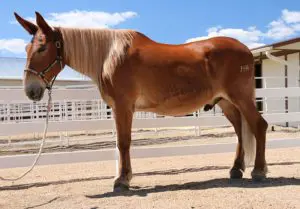
Roll had his most recent “leading for core strength postural workout” on May 23rd this year. However since then, I have been unable to pursue any more lessons during the entire summer due to business obligations.

He was scheduled for his regular farrier visits on May 18th, July 14th and on September 21st. During that time, he also had two chiropractic visits and was doing very well with only minor adjustments needed.

On October 17th, Roll had a short ride with Brandy in the Lucky Three Ranch North Pasture after being off all summer. He was rather disgusted with Brandy after she unseated her rider, Bailey, at the beginning of the ride by spooking at a shadow on the ground. Roll did great although I could tell he was a bit stiff from the onset, but loosened up and gained impulsion by the end of the ride.

Roll had his last massage on July 13 and continues to thrive at the age of 26 years old. On October 25, we discovered a sarcoid-like tumor on his right jaw, x-rayed it and will do a removal following next week’s vaccinations.

After being off all summer, I thought he did very well and this only reinforced my belief that core muscle really does sustain itself once the animal has spent at least two years doing very specific core muscle, postural exercises.


What’s New with Roll? Happiness is a Fanny Pack Full of Oats!

Roll is standing quietly as he usually does while I was speaking to a tour group with the gate wide open, but this was not always the case with him. He used to hide behind Rock and snort at me when he first arrived with Rock in December of 2010.
Behavior Modification is a reward system of training that requires that the trainer has the ability to distinguish between good and bad behaviors, to reward them promptly and appropriately…and, to do it politely with respect for the animal. The oats are a reward that is both safe and enjoyable for equines, and is something that they will continue to work for.

When dealing with an equine that is easily ten times your own weight, it is hard to imagine that the way we talk, touch and interact with our equine would really need to be ultra considerate, light and reassuring. However, if you want their complete cooperation, that is exactly what needs to happen. For instance, when applying fly spray talk gently and calmly, and be careful not to get the spray in their eyes…or it will burn and they will be less likely to comply the next time!

The same consideration hold true when bathing. Be careful not to get water in the ears, eyes and nostrils…and accustom the equine to cold water by spraying the feet and front legs first and work your way up to the face.


When you are kind and considerate, and give the equine time to adjust, even mechanical equipment like a massage thumper for muscle relaxation, or an equine vacuum cleaner used not only to clean but also to promote better circulation, can become a real source of pleasure and enjoyment for your equine.


When the equine is relaxed and accepting of the equine chiropractor, veterinarian and farrier, they are better able to do their jobs with maximum efficiency and successful outcomes.


And jobs you have to do like clipping, bridling and taking off the bridle all get much easier, preserving the trust between you. Now at 26 years old, Roll is a NEW draft mule!

What’s New with Roll? Leading the Hourglass Pattern
After being off last week, Roll was more than happy to come with me today. The air was brisk with a bit of a breeze and Roll was even a little snorty walking up to the work station. We spent a good amount of time with the Goody hairbrush getting the undercoat loose and I then went over him with the shedding blade to get the excess on top. He was still shedding hair all over, so I decided to go ahead with the vacuum cleaner. The vacuum cleaner serves a dual purpose: it pulls the remaining loose hairs from his coat while stimulating the capillaries to come to the surface of the skin. This increased circulation makes for an extremely soft and healthy coat. He still has a lot left to shed, but his hair now feels silky to the touch. I then put Roll in his surcingle, Eggbutt Snaffle bridle and “Elbow Pull” for his core muscle, postural leading lessons.

Roll practically pulled me down the alleyway to the dressage arena, but was very well behaved when we stopped to give Augie and Spuds a treat of oats. Roll was okay with sharing as long as I gave him more oats, too!

Roll and I then walked to the gate and he went through beautifully as always.

We marched along the pens and gave treats to all the mules who would be his audience.

Roll launched into the hourglass pattern on the lead rope with a lot of energy and enthusiasm. He squared up easily, but was still reluctant to put all the appropriate weight on his right hind foot.


He kept an upright balance through the turns and was markedly better in balance over the ground rails.

He even trotted a bit along side of the pens once I got out in front of him, but when I asked him to trot back to the gate, he was too tired! The chiropractor had come out to see him last week and said that he was locked up in his right hip, so it may be he needs another chiropractic visit this week as well.

At any rate, I was pleased with his progress and even though he missed his lesson last week, he still did better than in prior weeks. The hind feet were no longer twisting after his trim on May 19th.

It may very well be that he can graduate to the round pen soon for bulk muscle building. His core is solid now and after his workout, he was much tighter in the abs and filled in nicely over his topline.

Roll is carrying just a little more weight than I would like to see, but he did look less obese after his lesson and when we begin the bulk muscle building, it should disappear rapidly as the fat evolves into muscle. At twenty-six, Roll is doing so much better than I ever would have expected given his questionable history.


What’s New with Roll? Going for a Walk
Roll missed his exercises last week, so we thought we had better get out there today. Both of us were a bit tired of the arena, so we opted for a walk down the hayfield road. It was a rainy day and Roll had rolled in the mud, so we just did the hairbrush and shedding blade routine without the vacuum cleaner this time. Then we were ready to go.

Although he missed his exercises last week, he was still a bit better on the right hind foot. He did not want to put full weight on it, but I was sure he would do better after his walk in his core muscle building gear: the snaffle bridle with the dropped noseband, his surcingle and the “Elbow Pull” to make sure that the topline and abs would be engaged during the workout.

In the spring, we only turn out in dirt areas while the grass is growing. The equines will get turned out on grass on June 1st. This helps to maintain a nice stand of grass in all the turnout areas that will last all summer and into the fall. We never graze the equines on the hayfield pastures.

Contrary to popular belief, horse manure (or any manure that is not processed) will contain weed seeds and will contaminate the weed-free hayfields that we have managed to grow on 112 of our 127 ½ acres. There is an obvious size difference between us, but Roll is a gentleman and though he REALLY wanted to eat the grass, he still stuck to the routine as best that he could.

He did try to drag me off the road and over to the grass, but I just planted my feet, pulled on the lead rope as his right foot was coming forward and redirected him back down the road.

He was so good that I decided to let him have a bite and we then continued on down the road. We walked about a half mile out and back.

On the way back, Roll was breathing a bit hard, so I know he put his heart and soul into his exercise yet again. What a great guy! When he got back, he was fully weighting the right hind.


What’s New with Roll? Leading the Hourglass Pattern
Roll was a muddy mess when I went to get him today. He had been lying down and decided to roll in the wet dirt and pea gravel. Thank heavens it wasn’t all mud! I did my best to get most of it off of him, but clearly, the vacuum cleaner was not going to work for anything but getting the hair off the floor. I first went over his body with the hairbrush, then the shedding blade and afterwards, the dandy brush. Then I baby-oiled his mane and tail, put on his gear and we were good to go.

Roll seemed happier today than he had been last week. Roll was walking better and appeared to have gained some core strength back.

Instead of being really off behind, he was only slightly off and did not want to bear weight on the right hind in his squaring up…until the last one when he finally weighted the foot entirely.

Roll’s rein back was much better than last week. I had him checked by our resident farrier, LTR Ranch Manager Chad in case he was developing fungus in that foot (after his bout with White Line in his left hind). better to be safe than sorry, but he showed nothing but a packed-up foot, and that very well could have been the culprit since we just had a really good rain and everything was muddy in the arena where we were working.

It is truly amazing how slight, but visible his improvement has been from week to week. His whole body looked much more symmetrical this time. It is awesome to be able to celebrate each of Roll’s “little victories” along the way at 26 years old! However, Roll wasn’t too sure if he wanted to share his rewards with Sir Guy!!!
Roll decided that celebrating with a friend is probably okay and back to the work station we went to untack and then it was time for turnout!

What’s New with Roll? Leading in the Hourglass Pattern
Roll is very happy to be back to his core strength, postural leading exercises and today, he got his tail washed after a long and dirty winter. he seemed to enjoy getting his tail cleaned before his exercises.

Roll’s attitude is always good and he lets me know when he doesn’t want to go back to his pen afterward his lessons. He would prefer to stay with me all day long if he could.

He is beginning to really shed out a lot after this warm, dry spring. He really enjoys the brushing with a regular hairbrush to remove the under-hair, then the shedding blade for loose hair and finally the vacuum cleaner to promote good circulation. This regimen really promotes maximum shedding and a healthy summer hair coat.

He led well to the arena and went through the gate just fine although he wasn’t as flexible through his rib cage as I would have liked to see.

He did square up nicely when I asked on the other side of the gate.

His leading exercises went well and although he is still weak behind and wants to unweight one foot or the other when squaring up like he did after coming through the gate. The weight shifting is more general that specific and I think as he is strengthened, his stance will improve.

I also noticed that he really “sunk” behind before going over the ground rails…

…and then was able to maintain his posture over the rails, but “sunk” again on the approach every time.

The rein back was difficult for him, but he did comply with the slightest of cues as well as he was able.

When I ask him to put weight down evenly on the hind feet, he does comply, so this could just be more from habit than from actual pain, although there is clearly atrophy of the bulk muscle and weakness in the core muscles. He should improve with time and exercise.

Roll knows that I have his best interest at heart, so he is always affectionate, loving and willing to do anything and everything that I ask, but then I always keep my expectations for him realistic and doable.


What’s New with Roll? Indoor Arena Workout
Roll is very happy to be back to his core strength exercises. And after having to leave animals without their exercises for long periods of time, I cannot believe how quickly they can come back to good posture and overall strength. Roll had been off his exercises for over a year during his bout with White Line Disease.

When I led Roll up to the Tack Barn a week ago, he was dragging his toes in front, but I did not get it on video. So, this time, I wanted to get a “BEFORE” and an “AFTER” shot. We filmed him coming up to the Tack Barn work station, but after his core strength exercises last week, he still was not dragging his toes. His rhythm and cadence was regular.
My self-correcting device called the “Elbow Pull” puts the equine in their own individual good equine posture and keeps them there throughout the short (15-20 minute) leading lessons. The lessons take place in the hourglass pattern that we use to help them find optimum balance.
The fluid changes of direction in strategic places in the pattern challenge the equine to first arc one direction, then stop and square-up, then proceed on a new arc in the opposite direction.
Each time he stops and squares up, he is rewarded with crimped oats to keep his attention on the task at hand (and I change sides so I am always leading him from the inside of the arc to help maintain correct bend).
The serpentine actions through the pattern act like a “pendulum of balance,” bringing his balance back to center with every movement, so that when he does stop and settle, the internal balance comes to rest at his true “center,” or “core.”
The pattern is always done at the walk on the lead line and can be varied with trot down the long sides, and walk and trot over ground rails on the straight line after the equine’s balance is solid. The “Elbow Pull” cannot do this all by itself.
The combination of the handler’s posture, the equipment used (snaffle bridle and surcingle with the “Elbow Pull”), the action of the hourglass pattern, attention to smooth arcs, straight lines and square halts all contribute to the overall development of good equine posture and core muscle strength. Most conventional training techniques do not address core strength, only bulk muscle development over a weak core.
When true core strength is developed, it takes much less time for the equine to get back into shape after time off. The results of the top line and abdominal development over core muscle strength and balance with the use of the “Elbow Pull” never ceases to amaze me! After doing these exercises with all of my equines for so many years, it still doesn’t seem like it can be this easy…but it is!
To learn more about Meredith Hodges and her comprehensive all-breed equine training program, visit LuckyThreeRanch.com, MEREDITH HODGES PUBLIC FIGURE Facebook page, or call 1-800-816-7566. Check out her children’s website at JasperTheMule.com. Also, find Meredith on Facebook, YouTube and Twitter.
© 2017 Lucky Three Ranch, Inc. All Rights Reserved.

What’s New with Roll? Indoor Arena Workout
Roll is feeling much better and has not exhibited any lameness in a couple of days. I have been concerned about the muscle atrophy that he has experienced since he had the White Line Disease and the lameness that has prevented him from exercising much at all for almost a year. When he walked up to the Tack Barn work station, I noticed that although he was not lame, he was dragging his toes in front. I groomed him with the vacuum cleaner (circulation therapy) and then put on his bridle, surcingle and “Elbow Pull” and started for the indoor arena.

The “Elbow Pull” influence never fails to astonish me! Immediately, Roll was picking up his front feet and walking correctly through the alleyway of the barn and into the arena.
The workout went well, walking as he did in the beginning in 2010 in the hourglass pattern on the lead rope with strategic squared stops at every change of direction (with a reward of oats, of course!).
We traveled over the 1-inch ground rails at the center cones gate. Roll did not miss a step! It doesn’t take much to tune them up when you have laid a foundation of core strength and good posture!
We were a little awkward and off balance in this first lesson after being off for so long, but a few more leading lessons and he will be able to advance to ground driving again…maybe even riding later if we can keep him sound at 26 years old.
I left on his wrap for the duration of the exercise, but took it off after his workout. When returning to his pen, he was no longer dragging his toes in front. When core strength and balance is present, good posture and bulk muscle can be revived relatively quickly.









